When We Say Donations Are Down, You Can Believe They Are
Pulling in enough donations on a monthly basis to cover RSN’s basic operating costs is one difficult job … in normal times.
These times are anything but normal. We’re down a good 20% from last month at this time. While that may not seem like much, to a community based organization it’s the difference between keeping services turned off and keeping them on.
Slow down for a moment and do what you can to keep RSN doing this.
Marc Ash
Founder, Reader Supported News
If you would prefer to send a check:
Reader Supported News
PO Box 2043 / Citrus Heights, CA 95611
Follow us on facebook and twitter!
Live on the homepage now!
Reader Supported News
Members of Congress drafted a letter demanding information on an unprecedented but little-known report reconsidering U.S.-Saudi relations.
“A recalibration of the U.S.-Saudi partnership is long overdue in order to reflect President Biden’s important commitment to uphold human rights and democratic values in our foreign policy,” reads a draft of the letter obtained by The Intercept. The effort, led by Reps. Gerry Connolly, D-Va., Gregory Meeks, D-N.Y., and Jim McGovern, D-Mass., currently has more than 20 Democratic members signed on. “We look forward to your response on the status of the review of the entirety of the U.S.-Saudi relationship that takes into account such matters,” it continues.
During his Senate confirmation hearing, Blinken said the administration would conduct a broad review of the U.S.-Saudi relationship, but no review has been discussed publicly since then. According to a U.S. intelligence official with direct knowledge, however, a highly classified National Intelligence Estimate, or NIE, regarding the U.S.-Saudi relationship was completed sometime around the new year and included in Biden’s daily briefing. (The official spoke on condition of anonymity to discuss sensitive matters.)
NIEs are the gold standard of intelligence and draw on highly classified information gleaned from all U.S. intelligence agencies and often take months or even years to complete. This is likely the first NIE pertaining to Saudi Arabia since at least the George W. Bush administration and a sign of the deteriorating relationship between Washington and Riyadh. (Crown Prince Mohammed bin Salman reportedly declined a call with Biden amid the Ukraine crisis, signaling that Riyadh would not help alleviate soaring oil prices.) The report focused on subjects like MBS and Saudi Arabia’s decisions on oil production, the intelligence official said. Spokespeople for the National Security Council and Blinken did not immediately respond to requests for comment.
The letter, which two sources with knowledge of the discussions (but no authorization to speak publicly) say members plan to send to Blinken later this week, contains a litany of grievances about the desert kingdom’s conduct. Key among them is Saudi Arabia’s refusal to increase oil production to alleviate high oil prices amid Russia’s invasion of Ukraine. “Most recently, reports indicate that the Government of Saudi Arabia has rejected cooperation with the U.S. government following Russia’s invasion of Ukraine and the subsequent oil crisis,” the draft states. (As The Intercept previously reported, MBS has repeatedly shot down Biden’s pleas to increase oil production, sending gas prices spiking, much to the benefit of Russia, whose economy depends heavily on oil revenues.) “Instead of accepting appeals from our government to produce more oil, an initial step that would immediately lower prices for Americans across the country, the Saudi monarchy has elected to engage in talks with Beijing to discuss pricing a portion of its oil sales to China in yuan, a proposal that would weaken the reach of the dollar.”
The draft letter goes on to cite other concerns underscoring the urgency of the review’s release, including Saudi Arabia’s unilateral pursuit of nuclear technology, the lack of accountability for Khashoggi’s killers, its assault on Yemen, repression of its own citizens, their ballistic missile partnership with China, Saudi industrial espionage conducted against American companies, and a lack of progress on gender and labor rights. A range of Democrats are signing on to the letter, including members of the House Foreign Affairs Committee and House Armed Services Committee.
“We stand at an inflection point: The United States can continue our status-quo of broad support for an autocratic partner, or we can stand for human rights and rebalance our relationship to reflect our values and interests,” the draft closes. “How we move forward will send a strong message to democracies, activists fighting for democracy, and human rights defenders and will play an important role in our fight against authoritarianism around the world.”
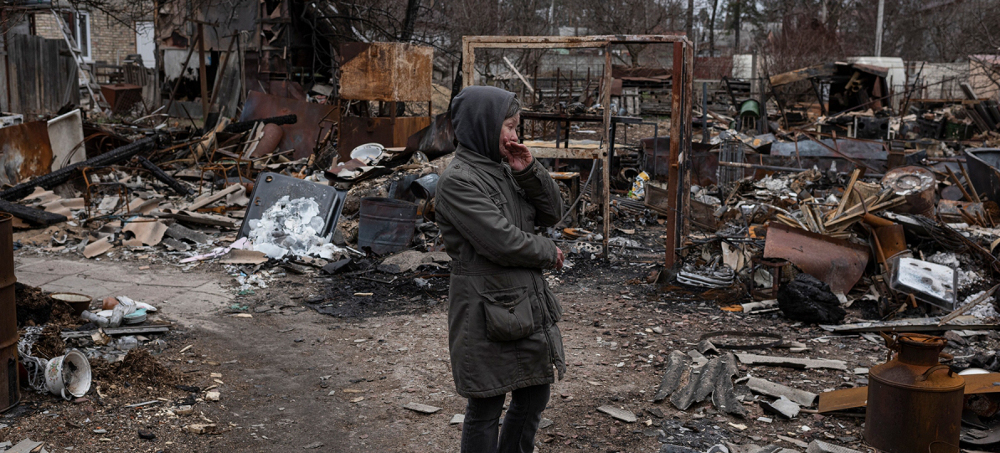 Olia, 53, stands next to destroyed constructions in her courtyard, on April 5, 2022 in Bucha, Ukraine. (photo: Alexey Furman/Getty)
Olia, 53, stands next to destroyed constructions in her courtyard, on April 5, 2022 in Bucha, Ukraine. (photo: Alexey Furman/Getty)
In Bucha and in other Ukrainian towns, the evidence of atrocities is everywhere. But will the perpetrators ever be held accountable?
The Russian government claims that the bodies are fresh. Over the past week, since reports of bodies with bound hands and mass graves began to filter out of Kyiv suburbs and isolated towns that were previously under Russian control, the Russian government has insisted that the atrocities there were not committed on their watch or by their soldiers, suggesting instead that Ukrainian troops committed them as they retook the city. Bucha’s survivors tell a different story.
Proving what happened, however, is a complex, almost-impossible task. For many, the first-hand testimony reported by journalists on the scene is enough to come to the easy conclusion: that Russian troops committed unspeakable horrors in Bucha. But every party involved has their own expectation of proof – and for international organizations ostensibly in charge of extracting justice from the immoral catastrophe of war, proof must be obtained meticulously and without fault. The wheels of these courts and systems move unbearably slow, and, despite their prominence, they remain vulnerable to denials and outright defiance by the parties responsible.
“The biggest challenge of what we do is attribution,” Brian Castner, a senior crisis advisor and weapons inspector for Amnesty International who recently returned from Ukraine, said. “It’s not a question of whether these people are dead – it’s how did they die, and was their killing lawful or not.”
Castner said his team often conducts dozens of interviews with survivors in order to assemble evidence for even a single case or incident. They take particular pains to preserve evidence and the chain of custody – something he worries that the scores of journalists now working in Bucha and other cities will not do. Castner has worked as a journalist; he says the standard of proof is much, much higher in official investigations (“You do it faster, we do it better,” he told me). Sometimes this standard is almost absurdly high: on a recent trip to Ukraine, Castner described speaking to a man who had been wounded by shrapnel from a suspected cluster munition. Castner, a former Explosives Ordinance Disposal technician in the U.S. military, waited until surgeons had removed the shrapnel from the man’s body, then photographed it to an evidentiary standard, all to confirm that in that specific case, cluster munitions had been used.
Even then, his work only serves as extensive hints for an actual investigation – NGO groups like Amnesty and HRW’s investigators turn their evidence over to international organizations like the International Criminal Court, which then conducts its own investigation, the results of which may eventually bring about a trial. Even then, war crimes trials often end in acquittals, as the pitfalls of any court are writ large across the inconsistent, arbitrary and flawed systems that claim to enforce international law.
“The pace of international justice is glacial, and very frustrating – frustrating to people in my job as well,” Castner said. “If I was imagining the trial that was happening every time that I do work, I would get pretty discouraged. I would simply say… it is easy to come to a moral judgment but it can be very difficult to gather enough evidence to come to a legal judgment.”
Governments, including the United States, often abuse this demanding burden of proof when confronted publicly with evidence of their war crimes. Over 20 years in Iraq, Afghanistan, and dozens of other countries, the U.S. government used dozens of justifications, lies, and denials to obfuscate the deliberate or accidental killing of civilians by its troops. The Russian government has been honing its disinformation strategies as well, deflecting blame from their own troops as well as friendly regimes after horrific chemical attacks in Syria, clogging public discourse with aggressive denials and blame-shifting. Their claims that Ukrainian troops inflicted the Bucha massacres on their own people are perfect examples of this disinformation strategy, which the country has used consistently since first invading Ukraine in 2014, forcing journalists and investigators alike to sink time and resources into disproving a shifting, nebulous web of propaganda and conspiracies.
“It’s absolutely infuriating. On a personal level it makes me angry,” Simon Ostrovsky, a special correspondent for PBS News Hour who was part of the first wave of journalists into Bucha earlier this month, says. “It’s not easy to do what we did and what we’ve been doing over the last week – looking at these dead bodies, people who suffered incredibly before they died. And to hear the perpetrators gaslighting the whole world and their own people and not just just denying what they did but laying it at the feet of the victims?”
But when he first arrived in Bucha, on April 3, Ostrovsky himself almost didn’t believe the claims. “I was skeptical initially because [the images online] were so horrific,” Ostrovsky says. “It seemed beyond my comprehension that that was possible.”
As Ostrovsky moved through the city, his skepticism vanished. His team saw several bodies with their hands tied, some in advanced stages of decomposition, some bearing bruises and other wounds consistent with beatings or torture. They interviewed the local funeral director, who told them he knew at least one of the victims personally, and led them behind the local church, where he had dug a mass grave. Ukrainian authorities claim that over 300 civilians were killed in Bucha. The town does not appear to be an anomaly – journalists have reported similar incidents in villages that were under Russian control across the country, and authorities fear that the death toll in some may be much higher than in Bucha.
Despite this shocking trail of violence, whether or not the Russian troops responsible for massacres in Ukraine, let alone the commanders who ordered them, ever face trial for their crimes may depend more on the violent outcome of the war than the painstaking investigations taking place behind the front lines. Investigators need access to people and places affected by war crimes; which the parties responsible rarely grant.
“If you win the war nobody will come and investigate in the territories that you control,” Pierre Mendiharat, the deputy director of operations at Médecins Sans Frontières (MSF) said.
Mendiharat has several teams active in Ukraine, and many members of MSF have observed war crimes committed by various world governments. On April 4, an MSF team came under fire while at a hospital in the Mykolaiv region of Southern Ukraine, and was quick to declare that they believed that they had been shelled by Russian forces, noting that the pattern of destruction could be indicative of cluster munitions. “We always try to publicly share when we are firsthand witnesses of such events,” Mendiharat said. “We always say what we believe to be true, and describe precisely what we are seeing.”
The pattern of constant denial is something Mendiharat said his teams observed in Syria as well, when healthcare facilities were deliberately targeted by the Russian and Syrian regimes. Mendiharat said he is not sure whether or not the Russians have established a pattern of deliberate targeting of hospitals yet in Ukraine, only offering what his team observed earlier in the month. In conflicts over the past decades, Mendiharat’s teams have witnessed bombings or attacks at healthcare sites in dozens of conflicts, including by troops from the U.S., Russia, Syria, Libya, and many non-state armed groups. Rarely, if ever, have they seen justice.
“Until now this ‘international justice’ has been the justice of the winners,” Mendiharat said. “If we want justice, we want justice for all the wars, not only when it applies to certain countries. In this case [that’s] not really justice – it’s more looking like revenge.”
In Ukraine, it may be a long wait for either justice or revenge – and there may be more victims than it is possible for investigators to count. The death toll of any war is never precise; we are always left with estimates and disputed figures. In Bucha, Ostrovsky said, “there were just so many bodies about that nobody could really know about all of them.” Each garden was a new potential crime scene. A few days later, he saw the same thing in the town of Borodyanka, a village 15 miles or so west of Bucha. Many of the dead there were killed by artillery shelling, but in a back garden, they found another corpse with its hands tied. A cloth bag was wrapped around its head; inside it was a mess. “There was no way of telling how he had died – whether he’d been shot or beaten to death with butt of a rifle – but it was clear that he was a detainee,” Ostrovsky said. Ostrovsky watched the police lift the body off the grass, stepping back in case the Russians had placed a mine underneath. Instead, all that was left behind was a patch of yellowed grass, in the outline of a man who died there. “The rest of the grass around him was green,” Ostrovsky said. “You know he’d been laying there for quite some time.”
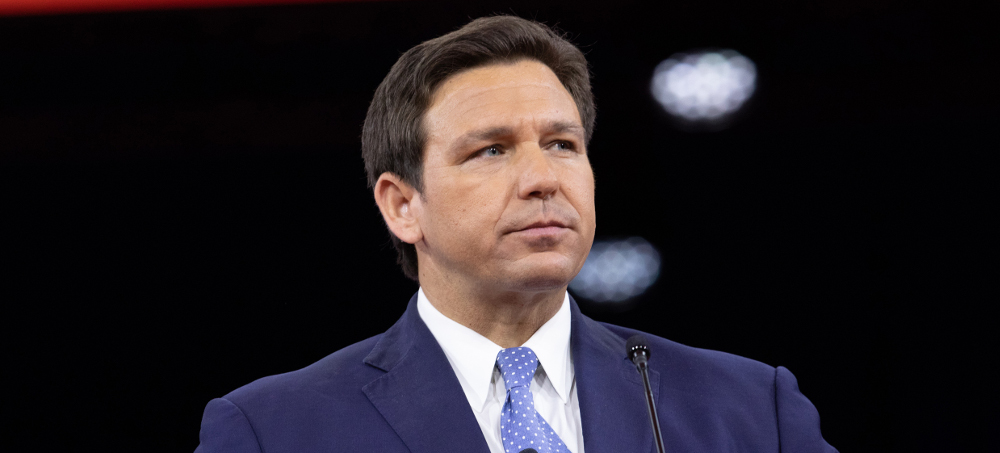 Governor Ron DeSantis seems eager to eliminate two congressional districts with large Black electorates giving Republicans a 20-8 edge. (photo: Joe Cavaretta/AP)
Governor Ron DeSantis seems eager to eliminate two congressional districts with large Black electorates giving Republicans a 20-8 edge. (photo: Joe Cavaretta/AP)
Governor seems eager to eliminate two congressional districts with large Black electorates giving Republicans a 20-8 edge
State legislatures, including Florida’s, usually draw a proposal for a plan that the governor approves or rejects. DeSantis vetoed the GOP-controlled legislature’s proposed congressional districts on 29 March after proposing his own map that would increase the number of GOP seats while eliminating two districts represented by Black Democrats. Leaders in the legislature said on Monday that they would not try to draft a new plan ahead of a special session next week, but instead were waiting for DeSantis, a likely 2024 presidential candidate, to submit his own plan.
“We are awaiting a communication from the Governor’s Office with a map that he will support. Our intention is to provide the Governor’s Office opportunities to present that information before House and Senate redistricting committees,” legislative leaders said in a Monday memo.
The legislature approved a plan earlier this year that would have given Republicans an 18-10 advantage in the state’s delegation. DeSantis’s proposal would have given Republicans a 20-8 advantage.
DeSantis appears focused on eliminating two congressional districts with sizable non-white populations. One of those is Florida’s 5th congressional district, which stretches from Jacksonville to Tallahassee, is 46% Black and represented by Al Lawson, a Black Democrat. He has also targeted the state’s 10th congressional district, which is majority non-white and is represented by Val Demings, another Black Democrat.
“The Florida legislature is caving to the intimidation of DeSantis and his desire to create additional Republican seats in Congress by eliminating minority-access districts,” Lawson said in a statement. “Again, I am not surprised, but disappointed with the legislature’s inability to fulfill their constitutional duties as elected officials without political interference from DeSantis.”
Mac Stipanovich, a longtime Republican strategist in Florida who has since left the party, told the Washington Post that Republicans were “prostrating themselves” for the governor.
“It’s just all about maintaining and acquiring power and holding on to office,” he told the Post. “What we’re witnessing is a mile marker on the road to one-man rule in Florida, at least for the time being.”
The Florida legislature passed two versions of the 5th congressional district earlier this year to try to satisfy the governor, but DeSantis rejected both. His office argued that lawmakers had unlawfully sorted voters based on race. One version also lowered the share of the Black voting population, and DeSantis’s office said they violated a provision of the state constitution that says the state cannot make it harder for minority voters who meet certain criteria to elect the candidate of their choice.
That rationale is “headspinning” and “inconsistent”, Michael Li, a redistricting expert at the Brennan Center for Justice, tweeted. The governor’s office essentially argued that the maps violated the US constitution by taking race into account too much and the Florida constitution for taking race into account too little.
On the federal level, however, DeSantis’s rationale echoes what the US supreme court has signaled about the Voting Rights Act recently. The court’s conservative justices have repeatedly voiced skepticism about the use of race in redistricting and are making it harder for litigants to show it is necessary to consider race when drawing district lines.
DeSantis, a former congressman, is eager for a court fight over Florida’s maps, NBC News reported. He also is taking aim at a 2010 amendment to the Florida constitution, overwhelmingly approved by voters, that sets guardrails on the redistricting process. Part of that amendment says districts cannot be drawn to abridge “the equal opportunity of racial or language minorities to participate in the political process or to diminish their ability to elect representatives of their choice”.
“I think our dispute very well may lead to saying that Florida’s redistricting amendments are not consistent with the 14th amendment’s equal protection clause,” DeSantis said in March. Republicans hold a 6-1 majority on the Florida supreme court.
The legislature is set to convene from 19 to 21 April for a special session on redistricting.
Florida, Missouri and New Hampshire are the last three states completing congressional districting. So far, there are 181 Democratic-leaning seats, 182 Republican-leaning seats, and 34 highly competitive seats among the 435 seats in the US House, according to FiveThirtyEight.
 Danish Prime Minister Mette Frederiksen, right, meets Ukrainian refugee children at Paradisbakken school in Nexoe, as she visits the island of Bornholm in Denmark, Thursday, April 7, 2022. (photo: Pelle Rink/AP)
Danish Prime Minister Mette Frederiksen, right, meets Ukrainian refugee children at Paradisbakken school in Nexoe, as she visits the island of Bornholm in Denmark, Thursday, April 7, 2022. (photo: Pelle Rink/AP)
“They have been forced to leave everything behind: their homes, their schools and often their family members,” Manuel Fontaine, emergency programs director for the United Nations children’s agency, told the U.N. Security Council on Monday. The figure includes children who were displaced internally as they left hard-hit areas and those who have fled the country since the war began.
More than 90 percent of the 4.5 million Ukrainians who fled the country are women and children, Fontaine said.
“Hundreds of schools and educational facilities have been attacked or used for military purposes,” he said. At least 142 children have been killed in the war, according to the United Nations, which acknowledges that its figures are incomplete.
Fontaine, who went to Ukraine last week, said of the invasion: “In my 31 years as a humanitarian, I have rarely seen so much damage caused in so little time.”
During his 10-day trip, Fontaine visited Lviv in western Ukraine, Vinnystria in central Ukraine and Dnipro and Zaporizhzhia in the southeast. The war “continues to be a nightmare for Ukraine’s children,” he said at a news conference Monday.
Children “have been hurt in the very places where they should be safest — their homes, emergency shelters, even hospitals,” he said.
At one hospital Fontaine visited in Zaporizhzhia, he said, the director told him that doctors have treated 22 children who had lost limbs because of the violence.
Families are risking their lives as they attempt to flee, he added, pointing to the Russian attack last week on the Kramatorsk train station, where civilians — including children — were killed as they waited to evacuate.
The majority of Ukrainian families who have managed to flee the country have gone to Poland, which has taken in more than 2.5 million refugees. Refugees are also crossing into Romania, Hungary and Moldova, among other countries. The European Union has granted Ukrainians temporary protection status that gives them the right to live and work in member states for up to three years. The refugees are also eligible to receive social welfare, housing, health care and schooling.
UNICEF has warned that children fleeing the war face a heightened risk of human trafficking and exploitation amid the chaos. Hundreds of children have crossed into neighboring countries unaccompanied, making them especially vulnerable.
In a statement Tuesday, the United Nations High Commissioner for Refugees said that it is “impossible to gauge how many Ukrainian refugee women and children might have been preyed upon by traffickers” but that so far, “known cases are thankfully few."
The agency called on governments to scale up child protection systems to support the influx of Ukrainian children. It said it was also increasing its support for national authorities to combat trafficking and would help establish safe stopping points for refugees in countries neighboring Ukraine.
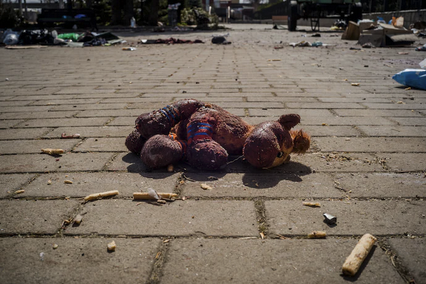
The fate of those who remain in Ukraine has been the subject of global concern and protest in Europe, as more reports emerge of Russian attacks on civilian buildings sheltering children. Russia bombed a theater in the besieged city of Mariupol last month where hundreds of civilians had taken refuge.
Secretary of State Antony Blinken referenced the theater — where “children” in Russian had been painted on the ground outside — when he accused Moscow of war crimes last month. Russian forces have also been accused of firing on cars of people trying to escape cities under attack, even when those cars have “children” scrawled on the windows.
Fontaine warned that children across Ukraine face “severely curtailed access” to services like health care, water and education. UNICEF is pre-positioning supplies across eastern Ukraine, which is bracing for a renewed Russian offensive, and sending cash to 52,000 households.
Facing a funding gap of about $59 million as of last week, the agency is appealing for more money to help address the “rapidly deteriorating humanitarian situation,” Fontaine said.
 From left: Bill Gates, Michael Bloomberg and Jan Koum. (photo: Lisa Larson-Walker/ProPublica)
From left: Bill Gates, Michael Bloomberg and Jan Koum. (photo: Lisa Larson-Walker/ProPublica)
An unprecedented trove of leaked IRS data shows who reported the most income in America from 2013 to 2018, as well as their tax rates, revealing that the very richest pay lower rates than the merely rich.
Thanks to an analysis of its unprecedented trove of IRS data, ProPublica is revealing the 15 people who reported the most U.S. income on their taxes from 2013 to 2018, along with data for the rest of the top 400.
The analysis also shows how much they paid in federal income taxes — and it demonstrates how the American tax system, which theoretically makes the highest earners pay the highest income tax rates, fails to do so for the people at the very top of the income pyramid. The top 400 earners pay noticeably lower tax rates than the merely rich; and, if you include payroll taxes, a married couple making $200,000 a year could end up paying higher tax rates than a person making $200 million a year. (The full analysis is here; it includes selected names beyond the top 15.)
Names That Won’t Surprise You
Scan the names on the list of the top 15 income earners and you’re certain to recognize several names — or at least the names of the companies they founded. Bill Gates hasn’t been involved in the day-to-day operations of Microsoft for over a decade, yet he still earned the most during the years we studied, reporting an average yearly income of $2.85 billion — and an effective federal income tax rate of 18.4%. Steve Ballmer, his former colleague, is also a well-known public figure, both for his time as Microsoft CEO and his current ownership of the Los Angeles Clippers NBA team. Ballmer’s average annual reported income of $1.05 billion landed him in the 10th spot on the list, and his effective federal income tax rate was 14.1%. The other side of the PC/Mac wars is represented here by Laurene Powell Jobs, widow of Apple founder Steve Jobs. Her average reported income of $1.57 billion ranked fifth-highest; she paid an effective tax rate of 14.8%. (ProPublica sought comment from everyone mentioned in this article. Nobody disputed the numbers cited here. Unless otherwise noted, representatives for people named in this article either declined to comment, declined to comment on the record or did not respond to requests for comment.)
Another well-known billionaire sits just below Gates on the list: Media and tech mogul and former New York City mayor Michael Bloomberg, with an average reported income of just over $2 billion, paid an effective income tax rate of 4.1%, by far the lowest rate among the top 15. (A spokesperson told ProPublica for an earlier article that Bloomberg “pays the maximum tax rate on all federal, state, local and international taxable income as prescribed by law,” and cited Bloomberg’s philanthropic giving.)
The presence of Amazon founder Jeff Bezos — either the first- or second-wealthiest person in America, depending on the day — won’t shock most people, but Bezos’s annual reported income during these years of $832 million put him only at number 15. He paid an effective tax rate of 23.2%; as we’ve previously reported, Bezos had so little income in a couple of recent years that he was able to pay $0 in federal income taxes in those periods.
Who Are These Others and Why Are They Paying Higher Tax Rates?
Tech billionaires dominate the top 15, but hedge fund managers account for a full third of the names on this list, and some of their incomes were just as huge. Most of them paid relatively high effective tax rates, especially compared to most of the tech sector representatives. Hedge fund managers often make their money through short-term trades, which are taxed at a much higher rate than when tech titans cash in on long-term investments.
The highest-earning hedge funder is Ken Griffin, founder of the Chicago-based firm Citadel. From 2013 to 2018, he reported an average income of nearly $1.7 billion, putting him fourth on the list. Griffin paid a tax rate of 29.2% during these years. (A spokesperson for Griffin said the tax rates in the IRS data “significantly understate” what Griffin pays, because they were lowered by charitable contributions and do not reflect local and state taxes. He also said Griffin pays foreign taxes, which aren’t included in IRS calculations of effective tax rate.)
Israel Englander, co-founder of Millennium Management, paid at a 30.8% rate, while the co-founders of Two Sigma Investments, David Siegel and John Overdeck, paid tax rates of 31.6% and 34.2%, respectively.
Some of this variation in rates reflects how people structure their businesses under tax law. Income earned by publicly traded corporations is taxed at the company level. When it’s passed on to big shareholders, such as tech billionaires, it can come in the form of dividends, which are taxed at lower rates than ordinary income. By contrast, the income from some manufacturing companies and hedge funds flows directly to company owners, who pay taxes on it, resulting in higher effective tax rates on average.
Where Are the Heirs?
Lists of the world’s wealthiest individuals are always heavily populated by heirs, ranging from descendents of old money to scions of more recently minted fortunes. Dozens of heirs made ProPublica’s list of 400 biggest income earners. Descendents and relatives of Sam Walton, founder of Walmart, claim 11 spots.
The DeVos family, heirs to the Amway fortune, also have multiple members in the top 400. Perhaps the best known is Betsy DeVos, who served as U.S. secretary of education during the Donald Trump administration. With a reported annual income of $112 million, she was the 389th-highest earner in this period.
Much like the tech titans who top the list, most of these heirs get their income from dividends or long-term investments, which are taxed at a lower rate. Their effective tax rates ranged from as low as 10.6% for Betsy DeVos to a high of 23% paid by Walmart heirTom Walton.
Don’t Forget the Deductions
Another key way that some top earners reduced their tax liability was to claim significant deductions, often in the form of large charitable contributions. This is particularly true for wealthy investors who are able to make their donations with shares of stock. Thanks to a generous provision of the tax code, they can then deduct the full value of the stock at its current price — without having to first sell it and pay capital gains tax.
Michael Bloomberg achieved a tax rate of 4.1% from 2013 to 2018 by taking annual deductions of more than $1 billion, mostly through charitable contributions. From 2013 to 2017, he also wrote off an average of $400 million each year from what he’d paid in state and local taxes. The 2018 tax overhaul limited that deduction to $10,000 — but also introduced a huge new deduction for pass-through companies that Bloomberg benefited from.
Wait — What About the Celebrities?
The earnings of actors, musicians and sports stars are a subject of nonstop scrutiny in the media, yet few celebrities cracked the list of the top 400 earners, which would have required them to report annual incomes of at least $110 million.
ProPublica’s trove has data on many celebrities. One who came close to the top 400 is basketball superstar LeBron James, who averaged $96 million a year in reported income. Grammy-winning singer Taylor Swift also came within reach of the top 400, averaging $82 million in reported income during these years. Actor George Clooney would have had to double his average income of $55 million to crack the top 400.
THE TOP 15
Here are the details on the top 15 income earners. Read the full analysis of the top 400 here.

For the full list of America’s top 400 income earners and their tax rates, along with our methodology, click here.
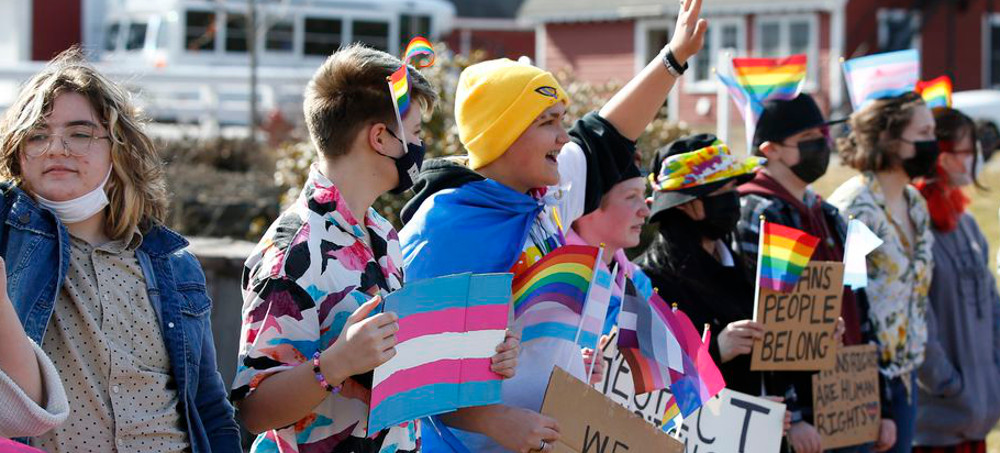 Students in Walpole, Massachusetts, protest anti-LGBT proposals in Florida and Texas. (photo: Jonathan Wiggs/Getty)
Students in Walpole, Massachusetts, protest anti-LGBT proposals in Florida and Texas. (photo: Jonathan Wiggs/Getty)
Why anti-LGBTQ laws and accusations of “grooming” children seem to be everywhere now.
In March, after Florida Gov. Ron DeSantis signed a bill restricting the kind of discussions and instruction public school teachers can have that involve “sexual orientation or gender identity,” copycat proposals popped up in at least three Republican-run states. Conservative proponents of these bills then launched new broadsides against LGBTQ people, accusing teachers of “grooming” school-age kids and queer allies of enabling pedophilia in their criticism of the bills and the chilling effects on school discussions.
In the span of what seemed like a week, old-school bigotry felt mainstreamed. Sitting members of Congress, cable news hosts, and conservative intellectuals coalesced around “ok, groomer” discourse as a new way to attack LGBTQ Americans — not just the teachers these bills are targeting. Their attacks come in a country that is more accepting of queer Americans than at any other time in history; about eight in 10 Americans back nondiscrimination laws protecting LGBTQ people. But suddenly, it seemed, 20th-century homophobia acquired a modern, QAnon-esque edge.
“If you’re against the Anti-Grooming Bill, you are probably a groomer or at least you don’t denounce the grooming of 4-8 year old children,” Christina Pushaw, DeSantis’s press secretary, tweeted at the beginning of March. On his talk radio show last week, conservative activist Charlie Kirk tied same-sex marriage and the acceptance of LGBTQ Americans to corrupting children: “We’re talking about gay stuff more than any other time. Why? Because they are not happy just having marriage. Instead, they now want to corrupt your children.”
The feedback loop of anti-LGBTQ legislation and “grooming” discourse reveals new dimensions to the conservative movement’s efforts to stymie the progress of recent years: Some members of the political right see opportunities to wield their advantages in the nation’s increasingly conservative courts against LGBTQ people — and opportunities to claw back the ground they’ve lost in the culture war as Americans’ opposition to discrimination grows.
What “Don’t Say Gay” and its conservative backers hope to win
Florida’s education law is couched in the language of parental rights and uses vague language to implicitly threaten LGBTQ teachers and allies with lawsuits. Though supporters had said the law bans inappropriate conversations about sexual activity with young students, the text never explicitly references discussions of sex — only explicitly forbidding conversations about “sexual orientation or gender identity.” The ban applies from kindergarten through third grade but leaves an opening for “age-appropriate” restrictions beyond those grades, while also not defining what “age-appropriate” means.
The legislation never uses the words “gay” or “trans,” but advocates argue that queer and trans Americans would be the primary targets of lawsuits by parents and officials behind the restrictions. Echoing the model of Texas’s abortion ban, Florida’s law deputizes parents as watchdogs, providing a path through the courts to punish schools and staff that violate the statute.
Legislatures in Alabama, Ohio, and Louisiana have since advanced similar proposals; Texas’s lieutenant governor is looking at introducing a bill when its next legislative session starts, and lawmakers in six other states, mostly in the South, have supported iterations of restrictions on LGBTQ identity in schools.
Some of these proposals are more explicit than Florida’s — Tennessee’s proposal seeks to ban books or material that support or promote LGBTQ “issues or lifestyle” altogether — but all offer a window into how social conservatives see opportunities to roll back protections for queer and trans people: score victories in the courts and make the cultural fight more extreme.
Their path to win legal fights looks more promising, with Republican majorities in these statehouses passing these bills on to Republican governors, expecting fights in lower courts, and biding time until a conservative majority on the Supreme Court reviews the challenges, Carl Charles, a senior attorney with the civil rights organization Lambda Legal, said.
Drawing on pandemic-era anger over school closures, mask-wearing, and the specter of critical race theory, state Republicans see an opportunity to rile up their most conservative constituents ahead of primaries, general elections, and a new Supreme Court term.
But what these bills communicate coyly, its supporters in media and politics have been saying out loud for quite some time: The way to win back lost ground in the culture war over LGBTQ people is to cast them as morally corrupt villains — and use schools as a starting point for a bigger cultural shift.
The extreme right’s “grooming” line reveals a note of desperation
Radical right-wing activists and commentators in recent weeks have been making literal accusations of pedophilia (in a callback to a trope from the 1970s and earlier) and grooming (which in its true sense means to “gain access to a potential victim, coerce them to agree to the abuse, and reduce the risk of being caught,” according to the Rape, Abuse, and Incest National Network). But they’ve also been increasingly using “grooming” as a casual insult to try to create a vague link between all LGBTQ people and cases of child abuse.
What started on the fringes, with conservative activists riding the coattails of last year’s anti-critical race theory moral panic, crossed over into mainstream media during the Supreme Court confirmation hearings for Judge Ketanji Brown Jackson last month. Sens. Josh Hawley (R-MO), Ted Cruz (R-TX), and Marsha Blackburn (R-TN) questioned the future justice’s thinking on gender, child abuse, and race. As Georgetown professor Don Moynihan wrote about Hawley’s line of attack, the point was “to create an association between Jackson and this broader trope” of child predators running rampant in public institutions. That spawned a universe of outrage in conservative media, further buoying the legislative action underway in Republican states.
Historical examples abound for how these kinds of moral panics bolstered discriminatory action against LGBTQ people since the 1970s. In that decade, California conservatives rallied against gay and and lesbian people to prevent them from working in public schools and anti-gay rights activist Anita Bryant led an effort to repeal anti-discrimination protections in Florida with her “Save Our Children” campaign.
Today’s “anti-grooming” line bears a resemblance to these old activist efforts, but it is becoming prevalent at a time when conservatives have lost many of the cultural and legal battles over gay rights and anti-discrimination protections, Cathryn Oakley, a senior counsel at the Human Rights Campaign, told me. Support for same-sex marriage has broad bipartisan support; a large majority of the country believes gay and lesbian people are “morally acceptable.” And those numbers have grown year over year.
“It’s very frustrating to see that we are having the same fight over and over again … but I believe that these folks are desperate. They have lost every fight they have picked on LGBT issues. They lost on trying to criminalize sodomy, they lost on marriage equality, they lost on bathroom bills, they lost on wedding services refusal — and we’re at 75 to 80 percent support for nondiscrimination laws,” she said.
Some of the loudest supporters of this effort have admitted this: “The alternative to the culture war is a culture surrender. There is no neutral option,” one reads. “The right needs to go scorched earth with ‘groomer,’” says another. “We are building a new model of conservative activism” with the grooming messaging, argues Christopher Rufo, a leading anti-critical race theory activist.
The rhetoric complements the institutional work that conservative think tanks are doing in pushing these bills. Lawmakers in these states have consulted organizations like the Alliance Defending Freedom, the Heritage Foundation, and American Principles Project in crafting proposals, Vice reported. (The Alliance Defending Freedom confirmed its involvement in a statement to Vox.) The progressive advocates I spoke with told me they see this feedback loop between radical activists, lawmakers, and think tanks as part of a more desperate ploy to use transgender people as a wedge issue to open the door to more mainstream attacks on trans and queer people in public life.
“We’re at this all-time high with people who are saying, ‘I don’t like anti-LGBT discrimination, I’m pro-nondiscrimination, this is my deal.’ And [conservatives] are losing their foothold,” Oakley said. “Where do they go from here? They pick on trans kids in the first place, because there are lots of well-meaning people who don’t totally understand what it means to be trans.”
This tension between well-meaning or naive Americans and their uneasiness with newer understandings of gender identity comes through in polling, which shows Americans remain a divided public on acceptance of trans people. Even a recent survey asking about Florida’s law shows one in four Democrats supports the policy. That gap worries advocates like Brandon Wolf, an activist with the group Equality Florida, who told me these bills are meant to exploit the general public’s lack of knowledge on trans people and create an opening for further attacks on queer and trans rights. So far, the scorched-earth strategy is working, but its staying power is being tested.
“Part of the strategy of the extremist right is to make so much noise that there isn’t space to have a really deep conversation about who people are,” he said. “We’re so busy trying to fight for the basic dignity and humanity of people that it becomes difficult to find the bandwidth or the spaces to share people’s stories. But that’s our challenge. That’s our job right now.”
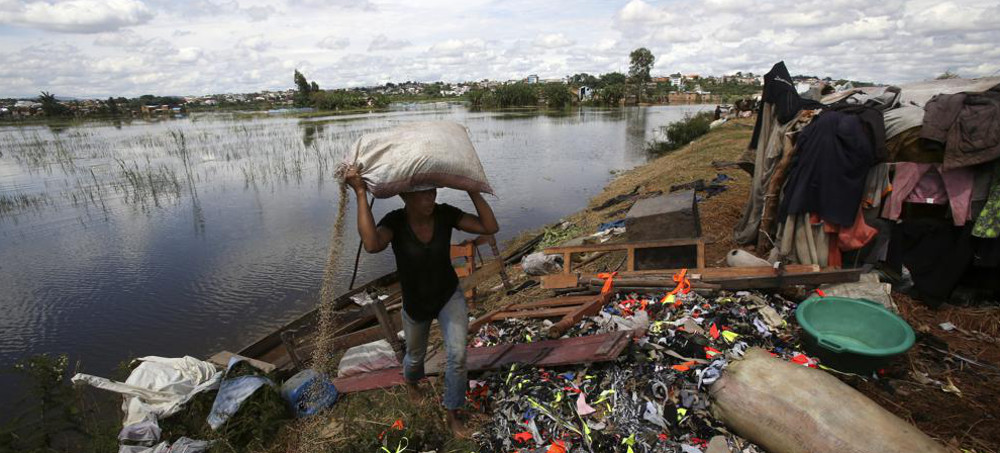 A man caries belongings from his house destroyed by tropical storm Ana in Antananarivo, Madagascar, Jan. 26, 2022. (photo: Alexander Joe/AP)
A man caries belongings from his house destroyed by tropical storm Ana in Antananarivo, Madagascar, Jan. 26, 2022. (photo: Alexander Joe/AP)
Multiple tropical storms that pummeled Madagascar, Malawi and Mozambique earlier this year were analyzed by the World Weather Attribution group, who determined that the storms were made worse by the increase in global temperatures. In just six weeks between January and March the region saw a record three tropical cyclones and two tropical storms make landfall. The heavy rains, storm surges and floods left more than 230 people dead and displaced hundreds of thousands across the region.
The countries remain vulnerable to devastating weather this year, with cyclone season set to end in May.
The team of climate scientists used established peer-reviewed methods, including weather observations and computer simulations, to model scenarios using both preindustrial global temperatures and today’s — which is approximately 1.2 degrees Celsius (2.2 degrees Fahrenheit) warmer. The difference between the models determined the impact of human-caused global warming.
Sarah Kew, from the Royal Netherlands Meteorological Institute and participated in the study, said they investigated the influence of climate change using 34 prediction models but data gaps made it difficult to determine the full impact of increasing greenhouse gas emissions.
“While our analysis clearly shows that climate change made the storms more damaging, our ability to establish precisely by how much was hampered by inconsistent data and lack of weather observations,” said Dr. Kew. “This would also help to improve forecasts of extreme weather events and their impacts.”
In both Madagascar and Malawi, the study was contrained by a lack of weather stations with suitable data. And of the 23 weather stations in the affected regions of Mozambique, only four had complete records dating back to 1981.
“Strengthening scientific resources in Africa and other parts of the global south is key to help us better understand extreme weather events fueled by climate change, to prepare vulnerable people and infrastructure to better cope with them,” Dr. Izidine Pinto, a climate system analyst at the University of Cape Town, said.
The 33-page study was conducted by 22 researchers, including scientists from universities and meteorological agencies in Madagascar, Mozambique, France, the Netherlands, New Zealand, South Africa, the UK and the US.
Special Coverage: Ukraine, A Historic Resistance
READ MORE
Follow us on facebook and twitter!
PO Box 2043 / Citrus Heights, CA 95611




No comments:
Post a Comment
Note: Only a member of this blog may post a comment.